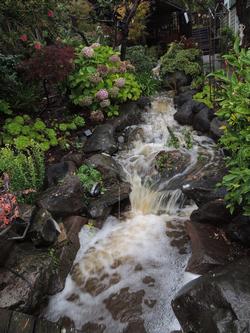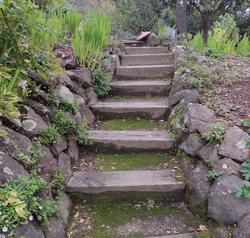Rain gardens present ways to bank water in the garden
-
Diane Lynch
-
We’re off to a great early start on filling our reservoirs - let’s hope the rains continue and get us out of this drought. But we must always remember that the next drought is just around the corner.
 This drainage rill in Tiburon has a catch basin that holds 1100 gallons of water, some of which is stored for garden watering. Photo: Diane Lynch
This drainage rill in Tiburon has a catch basin that holds 1100 gallons of water, some of which is stored for garden watering. Photo: Diane LynchAfter several years of not filling my drought arsenal of trashcans, I’ve pried them apart, and most are full. I cap them as soon as they’re pumped full of water from the catch basin at the bottom of my runoff stream. I monitor for mosquito larvae all winter. Then, as the garden dries out, I distribute the water to the thirstiest of my plants, mainly pots and a few hydrangeas, before turning on the irrigation in June or July.
There are simpler ways to store water in the garden passively. A rain garden is a way to store the water your hardscape sheds as runoff by letting it sink into the soil and recharge groundwater. Controlling runoff can help control erosion, which can impact a garden and home in negative ways. Building one is pretty simple. You’ll want to shape soil to create a low spot where the water will drain into the ground—think of it as a wide shallow bowl. If you have good drainage, this may be all that’s needed. If you have clay, which drains slowly, you will need to excavate down and line the bottom with perforated pipe and top with layers of crushed stone, filter fabric, topsoil, and mulch.
Ideally, the rain garden would be located in an area that catches runoff from your gutters and paved areas. The sloped sides would be planted with native grasses and flowering natives that will attract bees, butterflies, and birds, which can turn your garden into a pollinator haven if it wasn’t before. Go to https://sonomamg.ucanr.edu/files/122827.pdf for a list of natives that work well in rain gardens and bioswales. This can add an interesting focal point to the lawn or garden and save on irrigating that section of the garden since the natives won’t need water by the second or third year. This stairway does a good job of banking water into the hillside since the fill behind the treads has settled to catch water. Photo: Diane Lynch
This stairway does a good job of banking water into the hillside since the fill behind the treads has settled to catch water. Photo: Diane LynchOne of the important advantages of a rain garden is that soil is a good filter that will trap pollutants such as fertilizer, which most lawns rely on before getting to the bay or other waterways. In addition, soil microbes will break down toxins that might wash off hardscapes, such as a driveway. Of course, plants will take up some of the water too.
If the lay of your land is not ideal for getting water to a good drainage point, perhaps a bioswale or two could help. A bioswale is a channel to get water to your rain garden. They can be lined in stone or plants such as native grasses that won’t need irrigation in the summer months but can withstand water in the rainy season.
Cities have been using these techniques in median strips and parks for the last few years to divert runoff from streets and buildings into the land, so it stays out of waterways. If you go to ucanr.edu and put “bioswales” in the search bar, you can read about college campuses and cities all over the state that have in the spring installed these systems. The new library under construction in Tiburon will have a swale as required by the building code. Photo: Diane Lynch
The new library under construction in Tiburon will have a swale as required by the building code. Photo: Diane LynchWith luck, this will be a good winter to keenly observe your garden with the intention of creating a rain garden to capture some free runoff next winter. Our bay and streams will appreciate your efforts.



